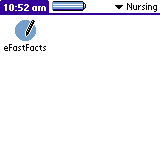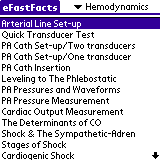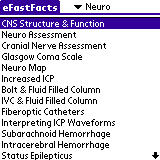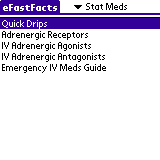 |
|
|
|
The Palm OS application consists of a self-executing compacted file (Palm_Install.exe) and readme.txt. for a total of 1.24MB. eFastFacts requires less than 1 MB of memory on the Palm devices, which is hard to believe when you discover the wealth of information that it contains. It uses minimal space considering the very large quantity of text, graphics, and calculator capability that is built into the program. Installation of this program to the newer Palm m515 PDA was effortless and without any difficulty. Following the prompts on the setup, it went easily to the PDA with the next 'sync' process. Initially we were surprised to see two icons on the device, eFastFacts and eFF_Content. Subsequent investigation of both icons revealed the eFF_Content icon is the database file and will then direct you to the other icon that will open the full version of this program. The attempted installation of this program to a Handspring Visor Platinum did fail however. After the hotsync, we received a message that Palm WebClippings Application was not installed on this device and that it was required to view the eFastFacts PDQ content. Subsequently, a Sony Clie s360 was sent to us from the company with the software already loaded for us to continue with this evaluation.(Editors Note: The company has reported difficulties in utilizing WebClippings and eFastFacts on Handspring products) We found out that eFastFacts will run on most Palm OS devices running OS 3.5 (with the WebClippings installed, which requires an additional 150K of memory) or the OS 4.0 (that comes pre-loaded with WebClippings). It will also be compatible with the soon to be released Palm OS 5.0. Due to the complexity of the program, the interlinking of text, extensive graphics, and the programmed calculators for loading dose and maintenance drip infusion calculations, the program must be loaded into, and run from, the main memory. The application will not run from SD cards, CF cards, Springboard Modules, MutiMedia cards or Sony's Memory Sticks. Once installed on the PDA, this program was easy to navigate from the first time we opened it. Help files are available both on the device as well as on the desktop for those that need assistance in navigating the program. Links to the website www.kathywhite.com is offered for additional FAQ files and for future updating of the program on your PDA. A support system is under development that will have the ability to provide assistance through email and even phone contact if needed. To start the program, you select the icon entitled eFastFacts. From the 'home' drop down list, you will find a complete listing of commonly used medical abbreviations, as well as the disclaimer, and the option for changing the font for easier screen viewing. At the top of the screen to the right is a drop down list where you can access the individual chapters as well as the calculators.
Under the Respiratory option, you will find a complete description of assessment of breath sounds, causes of hypoxemia, O2 delivery devices, ABG interpretation, modes of ventilation and weaning parameters. Diagnosis descriptions covered in full detail include pneumothorax, embolism, ARDS, and effusions with directions on insertions procedures, equipment setup and care of chest tubes and drainage units.
Under the IV/Blood section, you will find descriptions of various IV solutions, crystalloids and colloids, including blood products and transfusion needs, along with specific electrolyte imbalances and their treatment. The Labs/Charts screen will give you normal values for ABGs, isos, chemistries, hematology, and immunology, as well as normal findings for CSF and urine. There also is a comprehensive listing of normal and toxic levels for antibiotics, ethanol, and a wide variety of commonly used medications that need frequent drug level monitoring.
A separate section is provided for MedFacts where you can look up various types of medications and uses, from ace inhibitors, epidural analgesics, and neuromuscular blockades to sepsis and thrombolytic medications. We were especially pleased to see the current and up to date inclusion of Xigris with its administration procedure and protocol. To top it all off, there is a complete ACLS section with a full set of current algorithms and including all ACLS topics such as coronary syndromes, intubation, defibrillation, pacing and acute ischemic stroke protocol. We especially liked the tremendous variety of information available in one program as our ICU is a combined ICU/CCU/SICU and we need to have knowledge in all aspects of critical care regarding the patient's diagnosis, procedures, treatments and medications. This ONE program gives it all. With eFastFacts information is readily available and easily accessible. As a PDA program, it is lightweight and portable, easy to keep in your pocket for a quick reference. There were a few improvements we thought we might suggest for future versions. One would be the integration of the two icons with the initial installation into only one icon. This may eliminate some confusion and screen space as you do not need to see the database icon in order for the program to work. In the Calculations screen, a few additional conversions that are frequently used in the ICU could be added. For instance, we occasionally use the corrected calcium, corrected sodium, mean arterial pressure, anion gap, rule of six, and infusion management calculations as shown on the free MedCalc program we have. Also, the inclusion of TNKase (tenecteplase) as a thrombolytic agent would be beneficial to those of use who do use this drug occasionally. However, as with all programs of this type, the ability to update eFastFacts according to new trends in critical care will remain a major benefit to the continued usefulness of this program. In the future, we will be able to update this program at the Kathy White website in order to keep current with the trends. We are told that specialty chapters currently available for the book version (IABP, Trauma, Pediatrics, CV surgery) will also be integrated into a PDA format that will complement this program to assist those who need more specific information for these specialty services. eFastFacts retails for $44.95, much less than other references available, yet contains so much more pertinent and detailed information. We know that once you discover the wealth of information it holds, you will never want to be without it in a busy critical care unit.
Editor's notes: In view of the difficulties
experienced by the review team in loading the application on to
a Handspring product, and the stringent minimum requirements of
the Palm OS application, it is strongly recommended that you review
the "System Requirements for Installing eFastFacts" listed
on this
page of the company's website and request the free 15 day trial
version by emailing eFastFacts_Support@oms3.com
before purchasing the application.
|
|||||||||||||||||||





